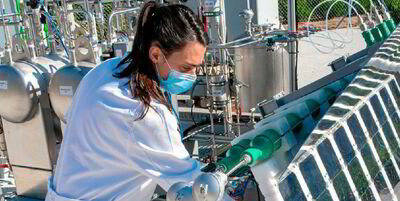"No One Will Need Stinkin' Electric, Gas, Ethanol, CNG or Diesel" - Direct Solar-to-hydrogen Developed For Ubiquitous Installation By 2030 Says Repsol, Making Fuel Cell Makers and Tree Huggers REALLY Happy
SEE ALSO: Hydrogen now firmly at the heart of the global race to net zero — for better or worse
'Very disruptive' direct solar-to-hydrogen commercially viable by 2030, says oil group Repsol
Spanish fossil player plans demo plant for converting PV power directly into green H2 without need for electrolysis as intermediate step
By Bernd Radowitz
Rechargenews.com
Oil & gas firm Repsol by 2024 plans to build a demonstrator plant at its Puertollano industrial complex in Spain for the production of renewable hydrogen by directly tapping solar energy, a process it claims could be commercially viable by the end of the decade. The Spanish group said it is aiming for the novel technology – which doesn’t need the intermediate step of electrolysis crucial to other green H2 production methods – to reach "commercial maturity" by 2030. Repsol is developing the process, called photoelectrocatalysis, together with Spanish gas grid operator Enagas.
The demo plant is slated to occupy close to half a hectare and have a production of 100 kilogrammes of renewable H2 per day. It is planned to be followed by 2028 by the installation of an industrial-scale plant of about 60ha and with a production capacity of up to 10 tonnes of the green gas per day.
'No electricity needed': oil company Repsol aims to turn solar straight into hydrogen
“It will allow us on the one hand to store renewable energy on a large scale, and on the other to use it as fuel in different sectors such as mobility, in the residential and industrial fields and also as a raw material in industry,” Repsol Technology Lab researcher Ana Martinez said.
While during electrolysis solar or other renewable power is first transported to an electrolyser where the water molecule is separated into H2 and oxygen, photoelectrocatalysis integrates the two steps into a single process.
Scientists have been investigating using sunlight to split water into hydrogen and oxygen.
“The device receives direct solar radiation and using photoactive material generates electrical charges that cause the separation,” said María Dolores Hernández, co-leader of the project.



